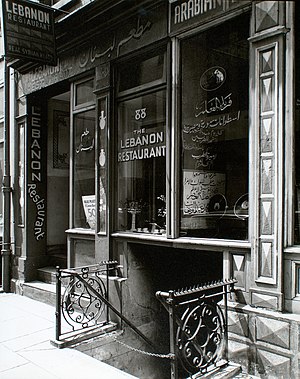
Back سوريا الصغيرة Arabic سوريا الصغيره ARZ سوریه کوچک، منهتن Persian Little Syria French Little Syria, Manhattan ID ലിറ്റിൽ സിറിയ, മാൻഹട്ടൻ Malayalam Маленькая Сирия Russian Little Syria Turkish Kichik Suriya Uzbek
Little Syria
سوريا الصغيرة | |
|---|---|
 Lebanon Restaurant, 88 Washington Street, Manhattan (1936) | |
| Coordinates: 40°42′29″N 74°00′50″W / 40.70806°N 74.01389°W | |
| Country | |
| State | |
| City | New York City |
| Borough | Manhattan |
| Community District | Manhattan 1[1] |
| ZIP Code | 10280 |
| Area codes | 212, 332, 646, and 917 |
Little Syria (Arabic: سوريا الصغيرة) was a diverse neighborhood that existed in the New York City borough of Manhattan from the late 1880s until the 1940s.[2] The name for the neighborhood came from the Arabic-speaking population who emigrated from Ottoman Syria, an area which today includes the nations of Lebanon, Syria, Jordan, and Palestine.[3] Also called the Syrian Quarter, or Syrian Colony in local newspapers it encompassed a few blocks reaching from Washington Street in Battery Park to above Rector Street.[2] This neighborhood became the center of New York's first community of Arabic-speaking immigrants. In spite of this name the neighborhood was never exclusively Syrian or Arab, as there were also many Irish, German, Slavic, and Scandinavian immigrant families present.[4]
The neighborhood declined as the inhabitants began moving out to other areas, Brooklyn Heights, the Sunset Park area and Bay Ridge, with many shops relocating to Atlantic Avenue, in Brooklyn.[5] The community disappeared almost entirely when a great deal of lower Washington Street was demolished to make way for the entrance ramps to the Brooklyn-Battery Tunnel.[6][7][8] The quarter was located at the southern edge of the site that would become the World Trade Center.[6] After the September 11 terrorist attacks the cornerstone of the Syrian St. Joseph's Maronite Church was found in the rubble.[8]
- ^ "NYC Planning | Community Profiles". communityprofiles.planning.nyc.gov. New York City Department of City Planning. Retrieved March 18, 2019.
- ^ a b Federal Writers' Project (1939). New York City Guide. New York: Random House. ISBN 978-1-60354-055-1. (Reprinted by Scholarly Press, 1976; often referred to as WPA Guide to New York City.), pp.76-77; Two other sections of New York were singled out as particularly Syrian in 1939, "the Syrian shops and coffee houses with their Arabic signs, on Atlantic Avenue" in South Brooklyn (p.463) and "a small Arabian and Syrian quarter" on Thatford Avenue near Belmont in Brownsville, Brooklyn (p.498).
- ^ Nigro, Carmen (November 19, 2015). "Remembering Manhattan's Little Syria". Milstein Division of United States History, Local History and Genealogy. New York Public Library. New York City. Retrieved November 21, 2015.
- ^ Jacobs, Linda K. (2015). Strangers in the West: The Syrian Colony of New York City, 1880-1900. Kalimah Press. ISBN 978-0983539254.
- ^ O'Brien, Jane and Botti, David (February 7, 2012) "Altered States: Preserving New York City's 'Little Syria'" BBC News Magazine
- ^ a b Dunlap, David W. (August 25, 2010) "When an Arab Enclave Thrived Downtown", The New York Times. Accessed August 25, 2010.
- ^ Cite error: The named reference
karpfwas invoked but never defined (see the help page). - ^ a b Dunlap, David W. Dunlap (January 1, 2012). "Little Syria (Now Tiny Syria) Finds New Advocates". The New York Times. Retrieved 2015-03-10.
Much of Little Syria was demolished in the 1940s to allow construction of entrance ramps to the Brooklyn-Battery Tunnel. What was left was bulldozed two decades later to make way for the World Trade Center. ...
© MMXXIII Rich X Search. We shall prevail. All rights reserved. Rich X Search